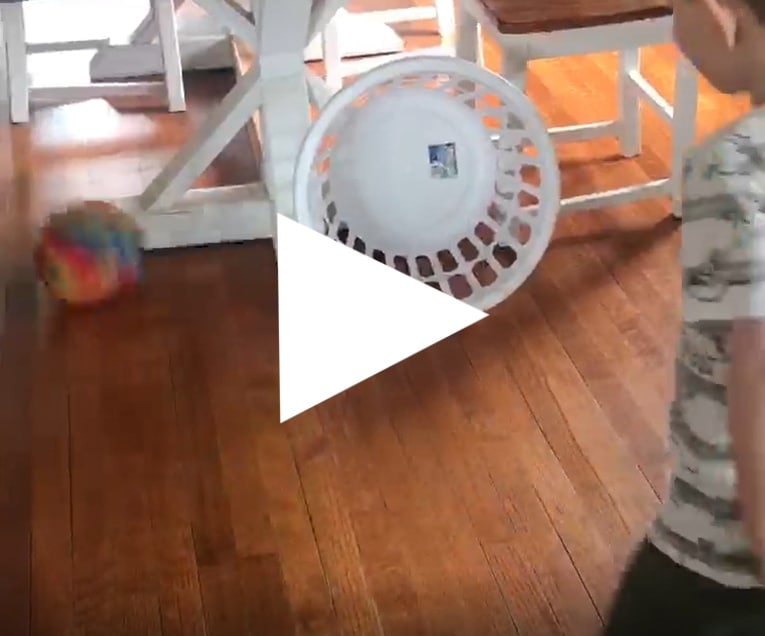With schools out of session and playground structures closed, our children have lost a lot of their normal physical activity and play throughout their days. Is your child acting out a little more or bouncing off the walls? Preschool-aged children should get up to 3 hours of play a day and older school-aged children should be getting about 60 minutes of moderate to vigorous activity a day (Center for Disease Control and Prevention, n.d.). A large majority of parents are still working from home and trying to find a balance between work and family life. How do we even attempt to meet those CDC guidelines while adhering to Gov. Whitmer’s “Stay Safe, Stay Home” Executive Order?
It’s simple, build an obstacle course for your kids! There are so many things located within your home, garage, and in your backyard that with a little bit of imagination and inspiration, you can keep your child moving and playing for hours. We know very well that our kids are easily occupied by technology and ‘screen time.’ However, this further deprives them of the movement their brain and body crave. It is our hope that as occupational therapists (OT) at BRAINS, we can give you a few simple tips and tricks to create a tailored and simple obstacle course that will keep your child active with a smile on their face for the quarantine days to come.
So, what makes a good obstacle course? Anything that gets your child moving! As an OT, our goal is to get kids crawling, climbing, jumping, pushing, and pulling. These kinds of movements are great at feeding your child’s sensory needs and helping them to develop many important skills needed in developing their bodies and independence.
Crawling is great for increasing the stability of the arm and hip joints while also making the trunk muscles stronger. Crawling can be completed a few different ways, but ideally, we want both hands and knees on the ground. This is typically a movement pattern that helps us establish how we walk. It also helps develop moving opposite sides of the body at the same time. Some ways to get a child crawling is to give them something low to go under. The obstacle should be just a little higher than your child’s back when they are on their hands and knees. In the video example we use an end table. You could also use a coffee table, a limbo pole, a chair, a desk, or even a tunnel to get them crawling.
Watch Sean’s DIY Obstacle Course!
Climbing is great for strengthening the upper body and hands. It forces us to support all our body weight through our arms. This may be difficult for some kids and so adjusting how high the obstacle is helps to make it easier or harder for your child. In our example we used the dining room table. I chose this because it was just the right height for my son and very stable. Some other items around the house you can use is a chair, a couch, a bed, or an island countertop. This will be a little easier outside if you have a good tree, a deck, or something stable stacked up high. Obviously, with climbing, there is a risk of falling so be careful what you allow your child to climb.
Jumping is great for strengthening the lower body. Jumping targets our hip, thigh, and calf muscles. It also helps to strengthen the knee joint. It provides a lot of sensory input into the bigger joints of our bodies. We can create obstacles where you must jump high and/or far. Beds and couches are obviously a favorite for children and can be used for this movement. Jumping is great in that you don’t even really need an obstacle. We had the idea to jump from book to book on the floor, but ultimately my son decided to step instead. This is a great example of your child grading the activity to meet their abilities.
Pushing and pulling are what we consider ‘heavy work’ in OT. They are great at creating large amounts of muscle force in both the arms and legs. It often helps calm kids as it requires so much energy. We used a laundry basket filled with clothes and some weights to push and pull. Some ideas are to load a child’s blanket with their toys and have them drag it across the room. If your child has a toy bin or bucket that can be used. Large pieces of furniture can be moved across the room. Wall pushes are also a very common activity.
In the video example, we address some other skills like kicking and throwing. Allow your child to help you create the obstacle course, doing it this way is a great cognitive activity and allows them to have some ownership and control and they will likely stay more engaged for a longer period. If you would like to consult with either of our OTs in helping you create a tailored obstacle course with the things you have available in your home, please let us know. Our OTs can provide these services over teletherapy.
To learn more about teletherapy at BRAINS, click here.
References
How much physical activity do children need? (n.d.). Center for Disease Control and Prevention, Retrieved from https://www.cdc.gov/physicalactivity/basics/children/index.htm
About the Author: Sean Crowell, MS, OTR/L, a licensed occupational therapist at BRAINS, works with children and adolescents in their two biggest life occupations; play and learning. Sean believes that movement is the key to unlocking the potential of the brain and body connection. Sean is an Air Force veteran and has experience in public school, vocational training center, and acute care rehabilitation environments.
